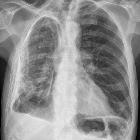Pleuritis
Pleurisy (or pleuritis) refers to the disease entity characterized by inflammation of the pleura. It classically presents as pleuritic pain.
Terminology
Pleurisy is often used by medical professionals and laypeople both to refer to the inflammation of the pleura and also the symptoms. Strictly we should reserve pleurisy for the name of the condition, whilst using pleuritic pain for the symptom.
Clinical presentation
Pleurisy typically presents as pleuritic pain, which is typically described as being sharp in nature. Classically pleuritic pain is exacerbated by any action involving a vigorous inspiration/expiration, e.g. sneezing, laughing, coughing, and deep breathing. Chest wall tenderness may be present. Occasionally a pleural rub can be heard.
Other signs and symptoms will depend on the underlying etiology.
Pathology
Etiology
This is a list of etiologies of pleurisy, not for pleuritic pain, which would be different.
- infectious
- viruses: many, e.g. adenovirus, coxsackie, cytomegalovirus, Epstein-Barr virus, influenza, mumps
- bacteria: tuberculosis, parapneumonic pleuritis
- parasites: amoebiasis
- exogenous agents
- asbestos
- drugs
- amiodarone, bleomycin, bromocriptine, cyclophosphamide, methotrexate, methysergide, minoxidil, mitomycin, oxyprenolol, practolol, procarbazine
- medication-induced pleurisy is a distinct phenomenon from the interstitial lung diseases caused by most of these agents
- inflammatory: rheumatoid arthritis, lupus pleuritis, Sjogren syndrome
- cardiac: Dressler syndrome
- gastrointestinal: inflammatory bowel disease, spontaneous bacterial pleuritis
- familial Mediterranean fever
- renal: chronic renal failure
Differential diagnosis
Clearly, in any patient presenting with acute pleuritic pain, it is crucial to exclude the top three diagnoses here.
- pulmonary embolism: most important diagnosis to exclude
- myocardial infarction: pleuritic pain atypical but certainly well-recognized
- pneumothorax
- pericarditis
- pneumonia
- trauma
- Bornholm disease
Siehe auch:
und weiter:

 Assoziationen und Differentialdiagnosen zu Pleuritis:
Assoziationen und Differentialdiagnosen zu Pleuritis:

